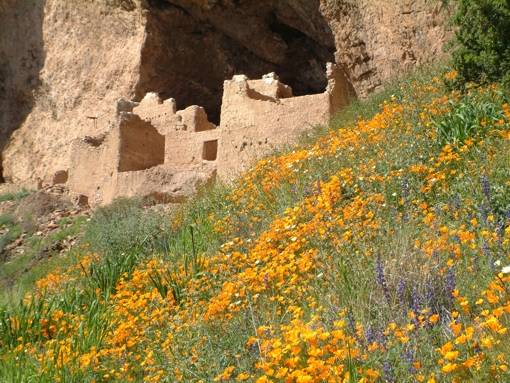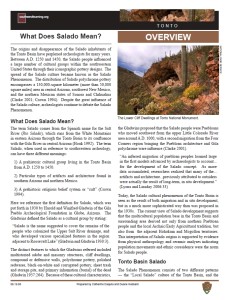The term Salado comes from the Spanish name Rio Salado, or the Salt River, that runs from the White Mountains in eastern Arizona through the Tonto Basin to its confluence with the Gila River in central Arizona. The term Salado, when used in reference to southwestern archeology, can have three different meanings:
- A prehistoric cultural group living in the Tonto Basin from A.D. 1250-1450.
- Particular types of artifacts and architecture found in southern Arizona and northern Mexico.
- A prehistoric religious belief system or “cult.”
Distinct cultural characteristics of the Salado as a group include multistoried adobe and masonry structures, cliff dwellings, compound or defensive walls, polychrome pottery, polished redwares, black-on-white and corrugated pottery, sheet trash, storage pits, and primary inhumation, or burial, of the dead.
As a cultural group, the Salado were primary centered in the Tonto Basin of central Arizona. However, Salado polychrome ceramics and iconography spread across the Southwest, resulting in what Patricia Crown (1994) identified as a regional religious cult, also called the Southwest Cult or the Salado Phenomenon. At its height, the distribution of Salado polychrome pottery encompassed a 130,000-square kilometer (more than 50,000 square mile) area in central Arizona, southwest New Mexico, and in the northern Mexican states of Sonora and Chihuahua.
The Salado began migrating out of the Tonto Basin after A.D. 1350, and by A.D. 1450, the Salado inhabitants of the region had moved on to other places and the production and spread of Salado polychrome pottery ceased. Native American oral traditions indicate that some Salado people moved north and east to the Hopi and Zuni peoples, west into the lower Salt River Valley, and south into the Rio Grande and northern Mexico regions.
Visit Tonto National Monument to see Salado artifacts and archaeological sites.
Fact Sheet (download):
- What Does Salado Mean? (pdf 1.62 MB)
For more information, see also Patricia Crown’s 1994 book Ceramics and Ideology: Salado Polychrome Pottery, published by the University of New Mexico Press, Albuquerque.


